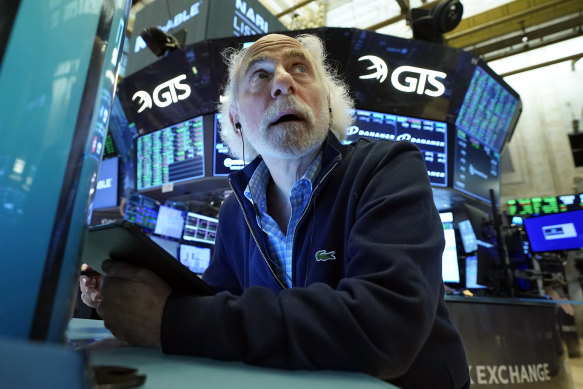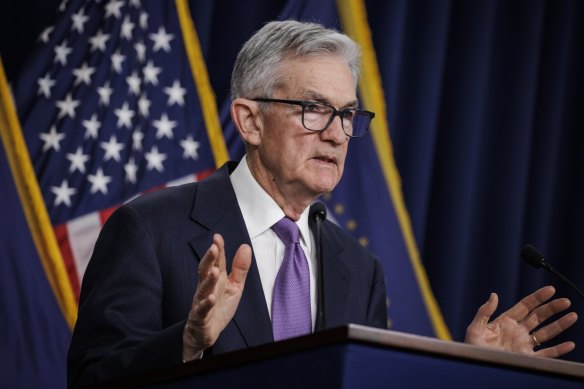This was published 1 year ago
Opinion
Join the dots: The war on inflation may have been won
Stephen Bartholomeusz
Senior business columnistChampagne corks were popping on Wall Street after the US Federal Reserve Board gave the clearest signal yet that it believes that it has tamed inflation, laying the foundations for several rate cuts next year.
The Dow Jones index hit record levels in a sharemarket that is now at its highest levels since the very end of 2021, while bond yields tumbled after the Fed ended its third consecutive meeting where its policy rate was left unchanged.

Wall Street surged overnight after the Fed’s latest statement. Credit: AP
It wasn’t the fact that the target range for the federal funds rate (the equivalent of the Reserve Bank’s cash rate) was left at 5.25 to 5.5 per cent that excited the markets, but rather that the Fed’s famous “dot plot” – the matrix of economic projections by the individual of the Fed’s Open Market Committee – showed that most members of the committee expect three rate cuts next year, and even more in 2025.
They added one extra 2024 rate cut since projections were published in September after slightly dialling down their expectations for the inflation rate (the rate in the final quarter of next year relative to the December quarter this year) from 2.6 per cent to 2.4 per cent.
The Fed’s expectations for the trajectory of rate next year are less bullish than the markets’, which are now factoring in more than a percentage point reduction in the federal funds rate, but historically the Fed has tended to be more conservative than investors.
Nothing said in Fed chairman Jerome Powell’s media conference could dampen the markets’ enthusiasm. He effectively confirmed that the central bank had taken the prospect of further rate hikes off the table and is now more focused on the timing of rate cuts.
“People (committee members) generally think that we’re at or near (the peak rate) and think it’s not likely that we will hike,” Powell said.
“The question of when will it become appropriate to begin dialling back the amount of policy restraint in place ... that begins to come into view and is clearly a topic of discussion out in the world and also a discussion for us at our meeting today,” he said.
The US inflation rate has been edging down and now stands at 3.1 per cent, with the measures the Fed watches most closely – core personal consumption expenditures (core PCE) – at 4 per cent in November. Powell regards that as “still too high”.
The Fed’s official target for inflation is two per cent, which the Open Market Committee members believe could be achieved in 2026. The median projection for the core PCE rate at the end of next year is 2.4 per cent.
The impacts of the Fed’s 11 rate rises in the cycle that started in March last year are still flowing through. Given the long lags between monetary policy decisions and their effects, the Fed will move ahead of the data to avoid overdoing the tightening and creating an avoidable recession.
The US economy is slowing and the Fed expects it to slow further. The median projection in the dot plot is for 2.6 per cent real GDP growth this year and 1.4 per cent next year, but it does appear that the Fed could pull off a cooling of inflation without plunging the economy into recession. That would be the central bankers’ holy grail of a soft landing.
The bond markets’ response to the decision and projections will help.
Between early May and late October, US bond yields rose aggressively – the two-year yield ran from about 3.8 per cent to more than 5.2 per cent and the 10-year yield from less than 3.5 per cent to briefly touch 5 per cent – which added a market-driven layer to the Fed’s monetary tightening.

Jerome Powell surprised the market with his talk of rate cuts.Credit: Bloomberg
The markets have been ahead of the Fed in anticipating rate cuts next year since those yields peaked in October. They responded to the Fed’s statement by pushing yields down further, with the yield on 2-year notes initially falling as much as 31 basis points. The 10-year bond yield fell to 4.02 per cent. Where the market was tightening financial conditions it is now loosening them.
In the early phase of this cycle, the Fed and other central banks were criticised for being too slow to recognise that inflation was breaking out of its long dormancy after the pandemic severely disrupted supply chains and ignited a cost spiral. The Fed, and its peers, regarded that as a transitory phenomenon.
As it has transpired, it was a much longer transition than the central bankers foresaw and, by the time they responded, the inflation genie was well and truly out of the bottle.
While they might have misjudged the strength and duration of the inflation breakout, however, the central bankers’ thesis now appears to have been broadly correct.
The US economy is slowing and the Fed expects it to slow further, but it does appear that a cooling of inflation can be pulled off without plunging the economy into recession.
Powell said that a key reason for the subsidence of US inflation without a recession (yet) was that the causes of this outbreak of inflation were different to historical episodes.
“This inflation was not the classic demand-overload, pot-boiling-over scenario that we think about,” he said.
With global supply chains now functioning normally and the labour market disruptions of the pandemic largely – albeit not entirely – overcome, the supply-side choke points that drive inflation rates have disappeared. Central banks can more easily deal with overly strong demand.
While the Fed does appear to be almost convinced it has done enough with interest rates to continue the decline in the inflation rate, it has left the other arm of its monetary policy, quantitative tightening (QT) – allowing bonds and mortgages it bought during the pandemic to mature without reinvesting the proceeds – in place.
The Fed’s balance sheet is running down at a rate of $US95 billion ($142 billion) a month – it’s shrunk by more than $US1.2 trillion since the QT program started in the middle of last year. The Fed’s total assets were bloated by a response to the pandemic that saw it expand from about $US4.1 trillion pre-pandemic to just under $US9 trillion at its pre-QT peak.
Where the Fed’s rate decisions affect the price of credit, QT drains liquidity from the US financial system, most particularly the banking system, and therefore also tightens financial conditions (and removes the Fed as a buyer of government securities) at a time when the market for Treasury securities is being overwhelmed by the sheer levels of supply being driven by the US’s swollen debt and deficits.
Apart from the rate cuts it envisages next year, an adjustment to the QT program to drain less liquidity and its eventual phasing out will likely be on the Fed’s agenda next year. That’s something else for investors to look forward to.
The Market Recap newsletter is a wrap of the day’s trading. Get it each weekday afternoon.